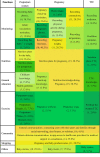A Comparison of Functional Features of Chinese and US Mobile Apps for Pregnancy and Postnatal Care: A Systematic App Store Search and Content Analysis
- PMID: 35252100
- PMCID: PMC8891489
- DOI: 10.3389/fpubh.2022.826896
A Comparison of Functional Features of Chinese and US Mobile Apps for Pregnancy and Postnatal Care: A Systematic App Store Search and Content Analysis
Abstract
Background: Pregnancy to postpartum (PtP) applications (apps) are becoming more common tools to document everything from pregnancy and delivery to nutrient allocation, life taboos, and infant medical examinations. However, the dependability, quality, and efficacy of these apps remain unclear. This study examined the features and functions of mobile PtP care apps accessible in China and the United States and to identify the major gaps that need to be addressed.
Methods: Apps were selected by searching the Apple App Store and Android Markets (in the US and China) for the terms "pregnancy" and "postpartum" in Chinese and English. The apps' security, quality, and effectiveness were investigated, and chi-square tests and analysis of variance were performed to examine the differences in characteristics between apps available in the US and China.
Results: A total of 84 mobile PtP care apps (45 from the US and 39 from China) were included. A total of 89.7% (35/39) of Chinese mobile apps did not provide safety statements or supporting evidence. The objective app quality ratings for Chinese and US apps were 3.20 ± 0.48 (mean ± standard deviation) and 3.56 ± 0.45, respectively (p > 0.05). A greater number of Chinese apps provided app-based monitoring functions, namely recording fetal size (n = 18, 46.2% in China vs. n = 3, 6.7% in the US), contractions (n = 11, 28.2% in China vs. n = 0, 0% in the US), pregnancy weight (n = 11, 28.2% in China vs. 0, 0% in the US), and pregnancy check-up reminders (n = 10, 25.6% in China vs. n = 0, 0% in the US). Meanwhile, a greater number of US apps provided exercise modules, namely pregnancy yoga (n = 2, 5.1% in China vs. n = 21, 46.7% in the US), pregnancy workouts (n = 2, 5.1% in China vs. n = 13, 28.9% in the US), and pregnancy meditation (n = 0, 0% in China vs. 10, 22.2% in the US) (p < 0.01). A medium security risk was identified for 40% (18/45) of apps in the US and 82.1% (32/39) of apps in China (p < 0.01).
Conclusions: The functionality and characteristics of in-store mobile apps for PtP care varied between China and the US. Both countries' apps, particularly Chinese apps, encountered issues related to a lack of evidence-based information, acceptable content risk, and program evaluations. Both countries' apps lacked proper mental health care functions. The findings suggest that the design of app features should be enhanced in both countries, and increased interaction between app creators and users is recommended.
Keywords: China; United State of America; functionalities; mobile app; postnatal care; pregnancy.
Copyright © 2022 Yu, He, Wang, Yang, Sun and Szumilewicz.
Conflict of interest statement
The authors declare that the research was conducted in the absence of any commercial or financial relationships that could be construed as a potential conflict of interest.
Figures
Similar articles
-
Quality assessment of pre- and postnatal nutrition and exercise mobile applications in the United States and China.Front Nutr. 2023 Jan 9;9:942331. doi: 10.3389/fnut.2022.942331. eCollection 2022. Front Nutr. 2023. PMID: 36698473 Free PMC article.
-
A Comparison of Functional Features in Chinese and US Mobile Apps for Diabetes Self-Management: A Systematic Search in App Stores and Content Analysis.JMIR Mhealth Uhealth. 2019 Aug 28;7(8):e13971. doi: 10.2196/13971. JMIR Mhealth Uhealth. 2019. PMID: 31464191 Free PMC article.
-
Mobile Health Apps on COVID-19 Launched in the Early Days of the Pandemic: Content Analysis and Review.JMIR Mhealth Uhealth. 2020 Sep 16;8(9):e19796. doi: 10.2196/19796. JMIR Mhealth Uhealth. 2020. PMID: 32609622 Free PMC article. Review.
-
Gaps and Future Challenges of Italian Apps for Pregnancy and Postnatal Care: Systematic Search on App Stores.J Med Internet Res. 2021 Aug 10;23(8):e29151. doi: 10.2196/29151. J Med Internet Res. 2021. PMID: 34383668 Free PMC article.
-
The Rise and Need for Mobile Apps for Maternal and Child Health Care in China: Survey Based on App Markets.JMIR Mhealth Uhealth. 2018 Jun 8;6(6):e140. doi: 10.2196/mhealth.9302. JMIR Mhealth Uhealth. 2018. PMID: 29884601 Free PMC article.
Cited by
-
App-Supported Lifestyle Interventions in Pregnancy to Manage Gestational Weight Gain and Prevent Gestational Diabetes: Scoping Review.J Med Internet Res. 2023 Nov 10;25:e48853. doi: 10.2196/48853. J Med Internet Res. 2023. PMID: 37948111 Free PMC article.
-
A mixed-methods study exploring women's perceptions and recommendations for a pregnancy app with monitoring tools.NPJ Digit Med. 2023 Mar 24;6(1):50. doi: 10.1038/s41746-023-00792-0. NPJ Digit Med. 2023. PMID: 36964179 Free PMC article.
-
Exploring user profiles and preferences for mobile apps promoting active lifestyles during pregnancy and postpartum: cross-sectional study.BMC Pregnancy Childbirth. 2025 May 10;25(1):558. doi: 10.1186/s12884-025-07635-8. BMC Pregnancy Childbirth. 2025. PMID: 40348982 Free PMC article.
-
Pregnancy Activity Levels and Impediments in the Era of COVID-19 Based on the Health Belief Model: A Cross-Sectional Study.Int J Environ Res Public Health. 2022 Mar 10;19(6):3283. doi: 10.3390/ijerph19063283. Int J Environ Res Public Health. 2022. PMID: 35328974 Free PMC article.
-
Quality of Mobile Apps for Child Development Support: Search in App Stores and Content Analysis.JMIR Pediatr Parent. 2022 Nov 8;5(4):e38793. doi: 10.2196/38793. JMIR Pediatr Parent. 2022. PMID: 36346656 Free PMC article.
References
-
- Jingmei M, Huixia Y. Proceedings of the 22nd World Congress of the International Federation of Gynecology and Obstetrics (Perinatal Medicine). J Perinat Med. (2018) 21:2. 10.3760/cma.j.issn.1007-9408.2018 - DOI
Publication types
MeSH terms
LinkOut - more resources
Full Text Sources




